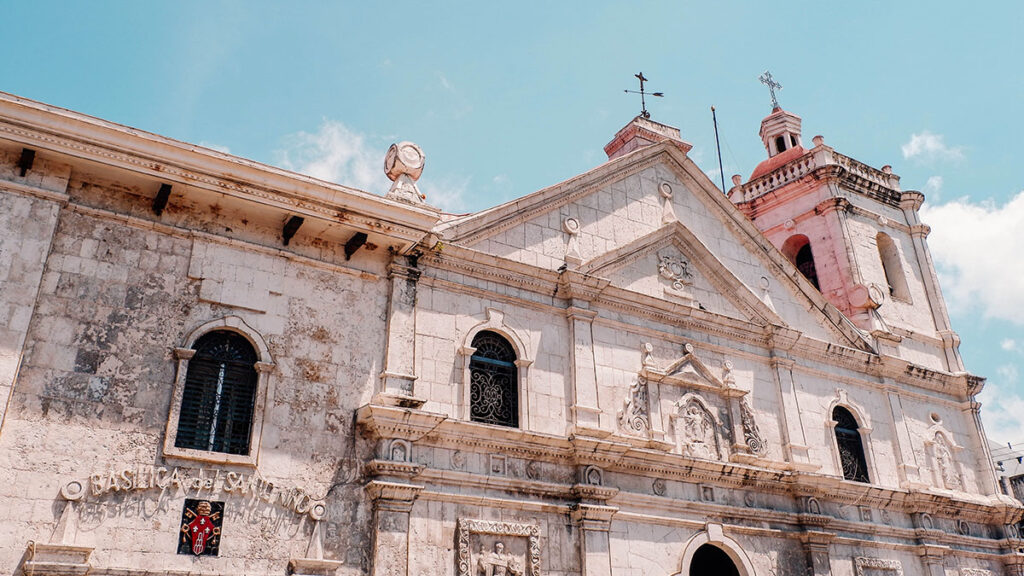
BLOG
PILGRIMAGE | FEATURES | NEWS
April 18, 2021
Declaration of Santo Niño Basilica as National Cultural Treasure highlights April 14 Quincentennial events

Roman Catholics in the Philippines commemorated the 500th anniversary of the arrival of Christianity in the country through a Pontifical Mass; declaration of the Basilica Minore del Santo Niño’s church and convent, and the Pavilion of the Magellan’s Cross as National Cultural Treasure (NCT); launching of Santo Niño at 500 commemorative stamps; opening of Santo Niño Exhibit; re-enactment of the First Baptism and Gifting of the Santo Niño Image to Doña Juana; and, a cultural show.
On April 14, 1521, Ferdinand Magellan’s expedition chaplain Fr. Pedro de Valderrama baptized Datu Humabon, his wife, and around 800 natives of what was then called Sugbo. The event is considered the birth of Christianity in these islands. Datu Humabon’s wife, christened as Queen Juana, was also gifted with the image of the Child Jesus, now more popularly known as Santo Niño.
Read more about the Santo Niño de Cebu as Baptism Gift to Queen Juana in 1521: https://www.santonino500.com/santo-nino-de-cebu-baptism-gift-to-queen-juana/
Read more about the history of Kaplag or the miraculous finding of the image of Santo Niño in 1565: https://www.santonino500.com/kaplag-sparked-formal-evangelization-of-the-philippines-worldwide-veneration-of-the-sto-nino-de-cebu/
His Excellency Archbishop Charles J. Brown, Apostolic Nuncio to the Philippines, presided over the Pontifical Mass at Plaza Sugbo fronting the Magellan’s Cross. Seven young children between the ages of 7 to 12 were also baptized during the mass. Three of those baptized are beneficiaries of the homeless project in Cebu City of the Santo Niño de Cebu – Augustinian Social Development Foundation, Inc. (SNAF), the social development arm of the Justice and Peace Commission of the Order of Saint Augustine (OSA)-Province of Santo Niño de Cebu – Philippines. More about SNAF’s programs: https://www.osasnaf.com/
Following the Pontifical Mass, a marker declaring the Basilica Minore del Santo Niño National Cultural Treasure was unveiled inside the Basilica. The National Historical Commission of the Philippines (NHCP) along with the representative from the National Museum of the Philippines and other government cultural agencies took part in the declaration ceremony. NHCP Chairman and National Quincentennial Committee (NQC) Executive Director, Dr. Rene Escalante, pointed out that the declaration is one of the highest recognitions the State can give to a particular built heritage. The recent marker is the fourth installed within the Basilica compound. NHCP unveiled one for the church in 1941, another one for the Magellan’s Cross on the same year, and another one for the Augustinian order unveiled in 2018. The declarations allow the cultural agencies to appropriate funds for the conservation of the Basilica without violating the constitutional provision on the separation of Church and State, Escalante explained in his speech.
The opening of the Santo Niño exhibit and the launching of the commemorative stamps of Santo Niño at 500 completed the Augustinian-related activities of the quincentennial celebration.
Earlier in the afternoon, a re-enactment of the first baptism and the gifting of the Santo Niño image was presented at Plaza Sugbo.
Cebu Archbishop Jose S. Palma, the Augustinian Prior Provincial, Very Rev. Fr. Andres Rivera Jr., OSA, Basilica Rector Rev. Fr. Pacifico C. Nohara, Jr., OSA, local government officials, parish heads and representatives graced the events.
A cultural show titled “Credo in Unum Deum” punctuated the series of activities.
The Republic of the Philippines NQC, the Roman Catholic Archdiocese of Cebu, and the OSA Province of Santo Niño de Cebu-Philippines organized the said events.
The Augustinian’s quincentennial events can be read at or at https://www.santonino500.com/ or at https://www.facebook.com/SantoNinoAt500
The Cebu Archdiocese quincentennial events can be read at https://www.facebook.com/sugboanongsimbahan
NQC events can be read at https://nqc.gov.ph/ or at https://www.facebook.com/nqc2021

